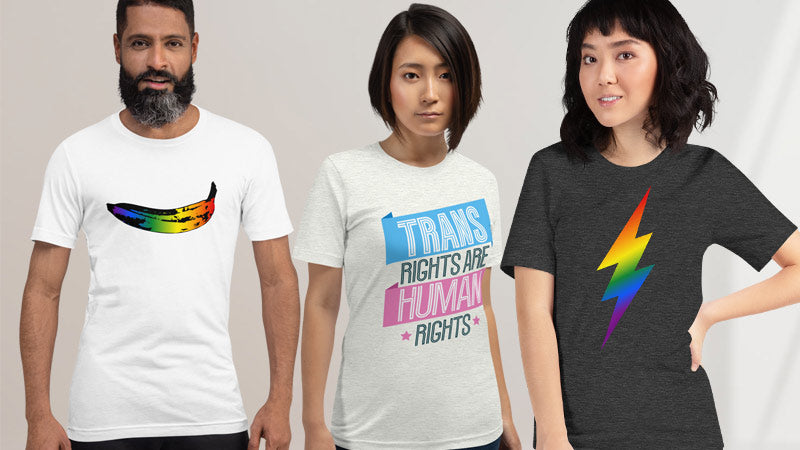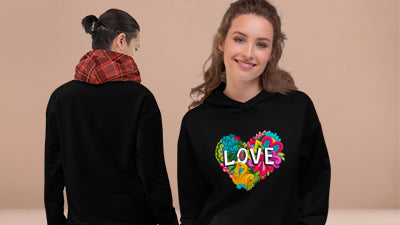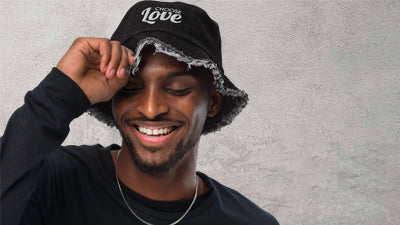Gilbert Baker And The Origin Of The Rainbow Pride Flag

The history of the LGBTQ+ community is full of amazing people. Activists who have risked their lives to win rights and equalities. Authors and film makers who have brought the queer experience into peoples homes to help build understanding. But there are few who have the legacy of Gilbert Baker. The man who created the flag that unites us all.
He styled himself 'the gay Betsy Ross' after the woman who is widely credited as having created the first official US flag. But as with so many people in our community, Gilbert Baker’s story is one of an extraordinary human struggling to make ends meet and persevering through adversity.
Gilbert Baker's Early Life
Born in Chanute, Kansas on June 2, 1951, Baker grew up in a conservative family, (his mother was a teacher and his father was a judge) in a conservative small town in a conservative state. He was an outgoing child but knew from a young age that he was different that made life difficult. On top of that he was drawn to the world of art and fashion, which alienated him even further.
He once said that “unlike Dorothy, when the tornado came, I ran right for it, saying, ‘Take me away!’”
After a year at college he was drafted into the US military in 1970 and after encountering terrible homophobia during basic training he opted to be a medic and, fortuitously, was stationed in San Francisco. It was there that he found the city’s thriving queer community and was able to live openly as a gay man.
Home In San Francisco
In the post-Stonewall era San Francisco was arguably the epicentre of the queer world and of the counterculture that had been born in London in the early 60s and quickly been embraced by the free spirits in the city.
After being honourably discharged in 1972 Baker became involved in the city’s drag scene and started using the sewing skills he had learned from fellow activist Mary Dunn to make costumes for himself and other drag queens and dancers in the city's underground gay nightlife scene.
“When Gilbert was in drag, like all queens, he sparkled, he was mischievous, defiant and yet motherly in some strange way,” his friend and fellow activist Cleve Jones told the San Francisco Chronicle in 2018. “Sometimes the reaction would make people speechless, or they’d ask, ‘What the f— does that mean?’”
Early Activism
Baker's experience of life in the city was making him much more involved in the fight for gay rights, which was now starting to become much more active, as police brutality towards the gay community was increasing, encouraged by the then city Mayor. Street beatings were a daily occurrence as an increasingly hostile attitude was adopted by the authorities.
As the community became more militant and protests more regular Baker was regularly asked to use artistic talents to create banners and posters for anti-Vietnam war protests and for gay-rights marches. And he became friends with prominent gay rights activist Harvey Milk, who, in 1977, would become the first openly gay elected official in California.
Milk understood the power of the banners Baker was producing. And the two worked closely together to create protest visuals as well as election material for Milk’s candidacy for the San Francisco Board of Supervisors.
The Origin Of The Rainbow Flag
In 1978 Milk was in office and eager to have a new symbol for the LGBTQ+ rights movement. He had seen the popularity of the Christopher Street Gay Liberation Day marches and wanted around that. He approached Baker to create a symbol for the community that would be inclusive and representative of all members. Milk believed that a visible symbol of pride and hope would help combat the discrimination and violence that many LGBTQ+ individuals faced at the time.
With further encouragement from his friend, the film maker Artie Bressan, Jr. on a day out in the city he decided to accept the challenge and started to think seriously about how that would look.
He wanted to move away from the two existing symbols. The inverted pink triangle that had been used by the Nazis to denote queer people was, in his opinion, emotionally too dark and he thought the Greek letter lambda was too obscure. He decided they needed something positive and uplifting. Something that celebrated love.
As he later said in his autobiography Rainbow Warrior My Life In Colour, “This was our new revolution: a tribal, individualistic, and collective vision. It deserved a new symbol.”
The idea came to him on a night out with best friend Cleve Jones at the Winterland Ballroom as they danced the night away. “Dance fused us, magical and cleansing,” he wrote. “We were all in a swirl of color and light. It was like a rainbow. A rainbow. That’s the moment when I knew exactly what kind of flag I would make.
“A Rainbow Flag was a conscious choice, natural and necessary. The rainbow came from earliest recorded history as a symbol of hope. A Rainbow Flag would be our modern alternative to the pink triangle.”
The Birth Of The Rainbow Flag
The colours of the flag were important and each had a significance. “Gilbert’s idea was to create something that reflects the diversity of the LGBT community,” Jones later told the Los Angeles Times.
He decided on eight colourful stripes representing diversity: hot pink (sexuality), red (life), orange (healing), yellow (sun), green (nature), blue (art), indigo (harmony) and violet (human spirit).
The San Francisco Gay Freedom Day decoration committee gave Baker $1,000 to create two rainbow flags for the event. So he bought 1,000 yards of muslin, 58 inches wide, 10lbs of natural dye in eight colours, and 100lbs of salt and ash.
With Jones and some other friends he went to the attic of the Gay Community Center in San Francisco, filled eight trash cans with natural dyes and dropped a strip of muslin into each. And then used his sewing machine to sew the first two flags.
And on June 25, 1978 at the San Francisco Gay Freedom Day Parade the two huge flags flew for the first time, and Harvey Milk rode under them. “I knew instantly when I saw the reaction that it was going to be something.” Baker said in 2008. “I didn’t know what or how or — but I knew.”
Cleve Jones stood with Baker when the flags were first unveiled and they marvelled at the reaction. “We stood there and watched and saw the flags, and their faces lit up,” he said in an interview with the New York Times. “It needed no explanation. People knew immediately that it was our flag.”
And then disaster. Within three months Harvey Milk was assassinated.

The Evolution Of The Flag
Milk’s assassination at the hands of former police officer and fundamentalist christian Dan White, who had resigned his seat as a supervisor in protest at the city adopting progressive gay rights laws was not just a hammer blow to the community, for Baker it was a personal tragedy, as he lost one of his closest friends.
It was, however, a step change for the rights movement and for the flag he’d created. People wanted one, partly to celebrate and commemorate Milk, and as it became more visible more people were asking for copies.
In 1978 the eight stripes became seven when it was realised that the pink dye was too expensive to be able to replicate the flags commercially. The reason for the turquoise colour being dropped was more about function.
It was realised that with seven stripes the flag couldn't be hung vertically from the lamp posts on San Francisco’s Market Street, because the centre stripe was obscured by the post. And as the parade organising committee wanted to fly the flag in two halves, Baker decided to drop the turquoise stripe and change the tone of the blue stripe. And with that, the flag becamse six stripes and Gilbert Baker’s legacy was cemented.

Years Of Art And Activism
In 1979 Baker started work at Paramount Flag Company in San Francisco. And while there he created flags for city mayor Dianne Feinstein, for visiting dignitaries and for the 1984 Democratic National Convention.
But Baker wasn’t just an artist and flag maker. He was also a prominent activist, and worked with organisations such as the AIDS Foundation and the Human Rights Campaign, and was a frequent speaker at events promoting equality and acceptance.
From 1981 to '83 he was a member of the Sisters of Perpetual Indulgence LGBTQ+ performance advocacy group under the name of Sister Channel 2001.
He said of the Sisters in his book that they were: “clowns and media marauders, straight out of the French Revolution. There was something magnificent and terrible about them, visually and symbolically.”
In 1984 Baker took his Sisters drag to the Academy Awards with fellow sister Sadie, Sadie, Rabbi Lady. Their extraordinary matching black sequin nuns habits, made by Baker, somehow didn't seem out of place and the pair mixed with movie stars in their signature white face paint. They collected money in a can labelled “Eddie Murphy’s disease,” a reference to the comedian’s homophobic stand-up comedy act.
Another of his radical protest outfits was Pink Jesus. Which consisted of a Stars and Stripes flag loincloth and head to toe pink body paint carrying a cross. This he wore for SF Pride parade in 1990 and then again in October a part of a protest at a fundamentalist Christian convention.

In the 1980s, he worked on the NAMES Project AIDS Memorial Quilt, a massive quilt conceived by Cleve Jones and made as a memorial to celebrate the lives of people who have died of AIDS-related causes.
He continued to create rainbow flags and on the anniversary of the first flag each year he would create a version to celebrate it. His work included fine art, photographs, paintings, silkscreens and has been included in exhibitions the world over.
But his art always went hand in hand with his activism.

Possibly the zenith came in 1994 when, to celebrate the 25th anniversary of the Stonewall riot, he made a rainbow flag that measured 30ft x 5,280 ft. and was carried by 5,000 people. It was a world record.
And then, in 2003, he outdid himself. In celebration of the Rainbow Flag’s 25th anniversary, he broke his own world record by creating a flag for Key West Pride which was one and a quarter miles long and stretched from the Gulf of Mexico to the Atlantic Ocean. After the Pride event was over he had the flag cut into sections, and distributed them more than 100 cities around the world.
A Life of Struggle
Despite his contributions to the LGBTQ+ community, Baker faced personal struggles throughout his life. Particularly with drug addiction and financial difficulties, and was often evicted from his homes due to his inability to pay rent. However, he continued to persevere and create art that inspired and uplift others.
In 2012 he suffered a stroke that cruelly took away his ability to sew. But even then he applied his own typically wonderful recovery therapy: applying beads and sequins by hand to costumes and gowns.
On March 31st 2017, only nine months after being invited to The White House for a reception to commemorate Pride month and shortly before he was due back in his hometown to celebrate the inaugural Gilbert Baker Film Festival, he passed away in his sleep at home in New York due to complications from that stroke. He was only 65.
Gilbert Baker’s Legacy
The Rainbow Flag that unites us so strongly will always be associated with Gilbert Baker and his vision of a world where all individuals are accepted and celebrated for who they are.
His contributions to the LGBTQ+ community and his art continue to inspire and uplift people around the world, and his legacy will live on for generations to come.
In 2015 more than 26 million people included a rainbow flag on their Facebook profile. It’s flown from Pride marches, to protests and from government buildings to balconies.
Despite the fact that it would have ended his financial struggles he refused to apply for a trademark for his creation. “It was his gift to the world,” Cleve Jones said. “He told me when the flag first went up that he knew at that moment that it was his life’s work.”











